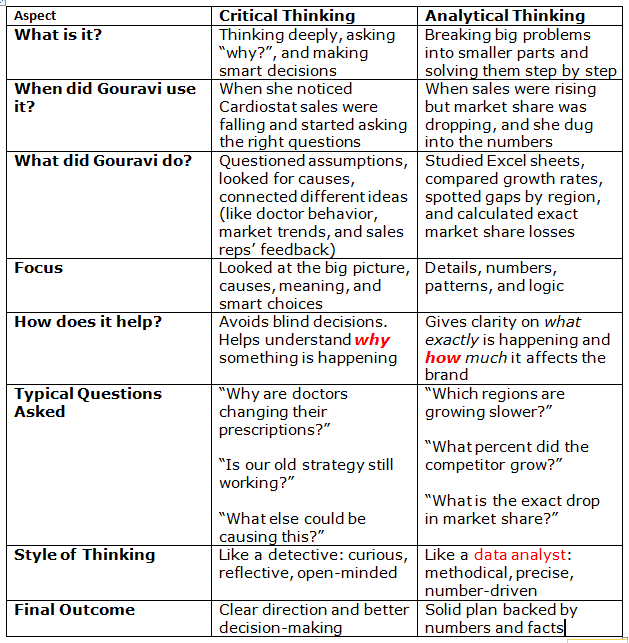The Empty Chair: That’s Happens When a Brand Manager Doesn’t Think – Brand Management 77

Preamble
Why is this Chair Empty?
In pharma marketing, the most dangerous threat isn’t competition—it’s the absence of thought.
The title may say “Brand Manager,” but without developing the skills and leveraging the power of analytical and critical thinking, this chair may go empty.
In pharma, where every decision can ripple through patient lives, market dynamics, and medical trust, a leader who doesn’t think is more than ineffective—he’s dangerous.
He doesn’t just miss opportunities; he misguides teams, misreads data, and misplaces the brand’s future. This isn’t about intelligence—it’s about intentionality.
Because when thinking stops, leadership collapses. And when leadership collapses, the brand begins to die—quietly, invisibly, and irreversibly.
To spiral your career growth upwards, it’s worth investing 9 minutes in reading this!
The absence of analytical and critical thinking isn’t a minor flaw; it’s a fatal gap.
In the high-stakes world of pharma, brand managers are not just custodians of strategy—they are stewards of trust. And trust demands thought.
The absence of analytical and critical thinking isn’t a minor flaw; it’s a fatal gap.
It turns leadership into lip service and branding into blindfolded guesswork.
If you’re leading without thinking, you’re not leading at all.
So, ask yourself: Are you sharpening your mind—or just warming the seat? Because in this industry, the cost of an empty chair is paid in lost credibility, lost connection, and ultimately, a lost brand.
Here’s a true story to help you understand what analytical thinking and critical thinking means for a pharmaceutical brand manager in India. (This is a true story: but the names have been disguised)
I have avoided jargon or complexity for your easier understanding .
Part 1: The Story of the Failing Brand
Meet Gourvi K, a young and ambitious brand manager at Canopus (India) Pharmaceuticals Ltd. Canopus has two divisions – “Hridayam” its cardiovascular division and “Sharkaram” its cardio-diabetic division.
Its domestic annual sales revenues are Rs. 1800 crores, Rs. 950 crores from coming from Hridayam and Rs. 850 crores from Sharkaram.
Gourvi manages Brand Cardiostat, which is an Angiotensin Receptor Blockers (ARB) and is indicated to manage hypertension when patients do not respond adequately to diet and exercise.
Cardiostat was launched five years ago. Initially, sales were strong. But now, sales are flat lining. Doctors aren’t prescribing it as much. Chemists say demand has dropped. And Gourvi is worried. And even prescription audit tells the same story – decline in prescriptions!
Gourvi knows something isn’t right. She has two options:
- Panic and blame external factors like competition, price wars, or economic slowdown.
- Pause and think critically about what’s going on.
She rightly chooses the second path – thinking critically for a solution. What is critical thinking?
Step 1: Ask the Right Questions
Gourvi doesn’t jump to conclusions. Instead, she sits down with her team and asks:
- Why exactly are prescriptions dropping?
- Have doctors stopped trusting Cardiostat?
- Has a competitor launched a new product?
- Is our messaging outdated?
- Are there novel studies or guidelines that affect how doctors prescribe this medicine?
Asking the 5 W’s and 1 H questions (Who, What, Where, When, Why, and How. These questions are used to gather comprehensive information about a situation, problem, or concept, aiding in deeper understanding and analysis.) is the first sign of critical thinking: asking good, deep questions instead of assuming things. And that’s what Gourvi did.
Step 2: Look at the Data, Not Just Opinions
The medical representatives and the front-line field managers of Hridayam say:
“Doctors just want newer drugs.”
But Gourvi doesn’t take that at face value. She digs into the prescription data. She notices something interesting:
- In metro and semi-metro cities, Cardiostat sales are stable.
- In tier-2 and tier-3 towns, there’s a sharp decline.
- She also finds that a new competitor drug, “Hyperzol,” from ‘KindHuman Laboratories’ has been aggressively promoted in those towns.
Now, things are starting to make sense.
Step 3: Connect the Dots, Not Just Collect Them
Gourvi now combines all the info she has:
- Doctors in small towns are shifting to Hyperzol.
- KindHuman Lab’s medico-marketing team are offering better education programs and newer scientific data.
- Cardiostat’s positioning hasn’t been updated ever since its launch.
- Marketing campaigns are still targeting urban doctors who haven’t changed much.
This ability to connect different pieces of information and see a pattern – that’s critical thinking in action.
Step 4: Challenge Old Assumptions
Pushparaj, a management trainee in the team says:
“But we’ve always positioned Cardiostat as ‘Simple dosing for better blood pressure control.’ Why change?”
Gourvi responds:
“Yes Pushparaj. I appreciate and understand your concern. But the newer ARBs like Hyperzol the one introduced from KindHuman Labs have done HEOR and the doctors in the smaller cities have accepted it. Look at the metros and the semi-metro’s. The flow of prescriptions is stable but isn’t growing at the pace of market growth. What worked at launch isn’t working now. Doctors need reasons to believe in us again.”
She’s not being disrespectful—she’s just not blindly accepting the past. That’s another sign of critical thinking: questioning assumptions respectfully, based on evidence.
Step 5: Test Ideas Before Acting Big
Now Gourvi has a plan:
- Update Cardiostat’s communication to highlight its long-term benefits and patient compliance.
- Start new CME (doctor education) programs in smaller towns inviting KOLs from AIIMS, KEM Hospital and even the AFMC.
- Train medical representatives and the front-line managers specifically to counter Hyperzol’s claims.
- Pilot this in the tier-2 and tier-3 towns of UP and Maharashtra before going national.
She’s not rushing. She wants to evaluate, observe results, and adjust if needed. That’s smart thinking—not just reacting but responding thoughtfully.
The Result?
Six months later, the pilot states show a 7% sales increase. Doctors say they’re happy to see fresh data and better engagement. Chemists notice more demand. Gourvi rolls out the campaign nationwide.
The brand is back on track—not because of luck, but because Gourvi used critical thinking at every step.
Moral of the Story
For a pharma brand manager in India, critical thinking means:
- Not accepting things at face value.
- Asking deep and relevant questions.
- Looking at facts, not just feelings.
- Connecting information from diverse sources.
- Challenging what’s always been done—with respect and reason.
- Making thoughtful, evaluated decisions.
It’s like being a detective, not just a manager. It’s the difference between reacting and understanding what’s happening—so you make better decisions for your brand, your team, and your company.
Part 2: Gourvi and the puzzle of Market Share
After the successful relaunch of Cardiostat, Gourvi was promoted to manage a portfolio of three brands. One day, she received a call from the company’s senior leadership.
“Gourvi, we’ve noticed something strange,” said the Marketing Director.
“Your brand Cardiostat is growing in sales, but its market share is declining. How is that even possible?”
Gourvi was puzzled.
“Sales are up. Doctors are prescribing. So how can our market share be going down?”
It was time for Gourvi to use her analytical thinking.
What is Analytical Thinking?
If critical thinking is about asking the right questions and connecting ideas,
analytical thinking is about breaking big problems into small parts, looking at numbers carefully, and using logic to find patterns, causes, and solutions.
Gourvi Gets to Work
She sat at her desk with her team. She opened up five Excel sheets and dashboards:
- Cardiostat’s monthly sales figures
- Market audit reports from shop audit firm
- Competitor data
- Prescription trends from the prescription audit firm
- Regional splits
She didn’t jump to any conclusion. She just stared at the numbers.
Step 1: Break the Big Problem into Smaller Parts
The big problem was:
Sales up, market share down.
She broke this down:
- Where is the growth in Cardiostat coming from?
- Which competitor brands are growing faster than Cardiostat?
- Is the overall market size increasing?
- Are all regions growing equally, or is growth uneven?
She’s not overwhelmed. She’s making the problem manageable. This is the first sign of analytical thinking.
Step 2: Look for Patterns in the Numbers
After breaking it down, she noticed something interesting:
- Cardiostat’s sales went up by 8%.
- But the entire market grew by 20%.
- A competitor brand, Zylotone, grew by 45%, especially in metros.
- Cardiostat’s growth came only from smaller towns.
So, while Gourvi’s brand was improving, others were improving faster. That’s why market share was falling.
She hadn’t seen this clearly before. But by slicing the data, the picture became crystal clear.
Step 3: Compare, Contrast, Calculate
She made a table:
She drew a conclusion:
Cardiostat is growing where the market is not. And it’s not growing where the real action is.
This kind of comparative thinking, supported by data, is what makes a manager analytical.
Step 4: Use Logic to Find the Root Cause
Gourvi dug deeper. She had a videoconference with the senior metro-based medical representatives and their front-line field sales managers and key opinion leader doctors.
What did she learn?
- Cardiostat’s message feels outdated to city doctors.
- Zylotone launched a smart packaging + reminder app for tech-savvy patients.
- Medical representatives from Zylotone were using clinical papers and e-detailing, while Cardiostat still used visual aids and reminder leave-behinds.
Gourvi now had her root cause:
Cardiostat was growing slowly because it wasn’t adapted to the urban market dynamics.
Step 5: Come Up with Logical, Data-Based Solutions
Based on her findings, she created a new plan:
- Segment doctors by region and tech-comfort level.
- For metros, create a digital-first campaign with real-world evidence studies.
- Add a patient adherence tool (like WhatsApp reminders).
- Build a specialized MSL team for metro cities with higher scientific engagement.
This wasn’t based on gut feeling. It was based on data, logic, and insight—the pillars of analytical thinking.
The Result?
Within a year of implementing the metro-focused strategy:
- Cardiostat’s market share stopped falling.
- In cities like Bangalore, Delhi, and Pune, it climbed back by 3%.
- The management team praised her structured approach.
Gourvi didn’t just “feel” her way through the problem.
She used analytical thinking to solve it with clarity and confidence.
So, What Is Analytical Thinking for a Brand Manager?
For a pharma brand manager in India, analytical thinking means:
- Breaking down complex problems into smaller parts
- Digging into data and finding meaningful patterns
- Using comparisons, calculations, and logical reasoning
- Not being influenced only by opinions or emotions
- Making decisions that are backed by numbers and facts.
It’s like solving a puzzle using both the mind and the math—seeing the full picture by understanding all the small pieces.
Here’s a simple comparison table (no jargon, no fluff) that shows the difference between Critical Thinking and Analytical Thinking—using Gourvi’s story as the base.

One-Line Summary:
- Critical Thinking helps you ask the right questions.
- Analytical Thinking helps you find the right answers—with numbers and logic.
Think Like Gourvi: A Smart Pharma Brand Manager Uses Both:
Critical Thinking + Analytical Thinking
Critical Thinking
“What’s really happening here?”
- Asks deep questions.
- Challenges assumptions
- Connects ideas from the field, market, and team.
- Sees the big picture.
✅ Gourvi used this when Cardiostat sales droppedShe didn’t panic. She asked why, looked at trends, and rethought her approach.
Analytical Thinking
“Let’s break it down and solve it step by step.”
- Digs into data and patterns.
- Compares numbers.
- Breaks problems into smaller parts.
- Uses logic and facts.
✅ Gourvi used this when market share was falling despite sales growth👉 She spotted regional gaps, competitor growth, and fixed the root problem.
Together They Help You:
✅ Ask the right questions✅ Find the right answers✅ Make smart, confident brand decisions
BE LIKE GOURVI: Use your mind for meaning and your math for mastery.
To conclude, the title may say “Brand Manager,” but without the power of analytical and critical thinking, it’s just an empty chair.
In pharma, where every decision can ripple through patient lives, market dynamics, and medical trust, a brand leader who doesn’t think is more than ineffective—he’s dangerous.
He doesn’t just miss opportunities; he misguides teams, misreads data, and misplaces the brand’s future.
This isn’t about intelligence—it’s about intentionality.
Because when thinking stops, leadership collapses. And when leadership collapses, the brand begins to die—quietly, invisibly, and irreversibly.

If you do not master the skills of Analytical Thinking and Critical Thinking You Are…